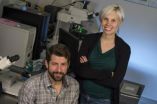(Press-News.org) Rice University bioengineers are developing a simple, highly accurate test to detect signs of HIV and its progress in patients in resource-poor settings.
The current gold standard to diagnose HIV in infants and to monitor viral load depends on lab equipment and technical expertise generally available only in clinics, said Rice bioengineer Rebecca Richards-Kortum. The new research features a nucleic acid-based test that can be performed at the site of care.
Richards-Kortum, director of the Rice 360˚: Institute for Global Health Technologies, and her colleagues reported their results in the American Chemical Society journal Analytical Chemistry.
The proof-of-concept work by co-lead authors Zachary Crannell and Brittany Rohrman, both graduate students in the Richards-Kortum lab, follows their similar technique to detect the parasite that causes the diarrheal disease cryptosporidiosis, reported earlier this year.
The new technique would replace a complex lab procedure based on polymerase chain reaction with one that relies on recombinase polymerase amplification (RPA), a method to quickly amplify – that is, multiply – genetic markers found in blood to levels where they can be easily counted. In a test the team calls qRPA, a specific sequence in HIV DNA is targeted and tagged with fluorescent probes that can be seen and quantified by a portable machine. Software analysis of the fluorescing DNA allows clinicians to determine with great accuracy whether the virus is present in a patient's blood and/or how much is there.
The researchers calibrated the test by also amplifying an internal positive control not found in human blood. "It's amplified by the same primers as the HIV sequence, so it tells us that the assay is working properly," Rohrman said.
The students originally intended their work to look for HIV in infants, but the technique can also help to track viral loads in older patients. "It's important for clinicians to be able to quantitatively monitor patients' viral loads in order to ensure the disease is responding to therapy," Crannell said.
To be clinically viable, a DNA-based test for HIV has to be able to quantify virus loads over four orders of magnitude, from very low to very high, the researchers said. They reported the Rice test easily meets that goal.
They are developing tools for low-resource settings where high-tech lab equipment is not available. Although they used a thermal cycler, the researchers are working on a technique that will keep the entire procedure between room and body temperatures so that it can be performed at the point of care in the developing world.
The research was funded by a grant from the Bill & Melinda Gates Foundation through the Grand Challenges in Global Health Initiative.
INFORMATION:
Read the abstract at http://pubs.acs.org/doi/abs/10.1021/ac5011298
Follow Rice News and Media Relations via Twitter @RiceUNews
Related Materials:
Rice 360˚: Institute for Global Health Technologies: http://www.rice360.rice.edu
BioScience Research Collaborative: http://brc.rice.edu/home/
Located on a 300-acre forested campus in Houston, Rice University is consistently ranked among the nation's top 20 universities by U.S. News & World Report. Rice has highly respected schools of Architecture, Business, Continuing Studies, Engineering, Humanities, Music, Natural Sciences and Social Sciences and is home to the Baker Institute for Public Policy. With 3,920 undergraduates and 2,567 graduate students, Rice's undergraduate student-to-faculty ratio is 6.3-to-1. Its residential college system builds close-knit communities and lifelong friendships, just one reason why Rice has been ranked No. 1 for best quality of life multiple times by the Princeton Review and No. 2 for "best value" among private universities by Kiplinger's Personal Finance.
Rice developing mobile DNA test for HIV
Diagnostic test aimed at detecting virus in infants, viral loads in older patients in low-resource settings
2014-06-05
ELSE PRESS RELEASES FROM THIS DATE:
Iowa State, Ames Lab researchers find the mechanism that forms cell-to-cell catch bonds
2014-06-05
AMES, Iowa – Certain bonds connecting biological cells get stronger when they're tugged. Those bonds could help keep hearts together and pumping; breakdowns of those bonds could help cancer cells break away and spread.
Those bonds are known as catch bonds and they're formed by common adhesion proteins called cadherins. Sanjeevi Sivasankar, an Iowa State University assistant professor of physics and astronomy and an associate of the U.S. Department of Energy's Ames Laboratory, has described catch bonds as "nanoscale seatbelts. They become stronger when pulled."
But how ...
Short nanotubes target pancreatic cancer
2014-06-05
Short, customized carbon nanotubes have the potential to deliver drugs to pancreatic cancer cells and destroy them from within, according to researchers at Rice University and the University of Texas MD Anderson Cancer Center.
Pristine nanotubes produced through a new process developed at Rice can be modified to carry drugs to tumors through gaps in blood-vessel walls that larger particles cannot fit through.
The nanotubes may then target and infiltrate the cancerous cells' nuclei, where the drugs can be released through sonication – that is, by shaking them.
The ...
LSU biologist James Caprio, Japanese colleagues identify unique way catfish locate prey
2014-06-05
BATON ROUGE – Animals incorporate a number of unique methods for detecting prey, but for the Japanese sea catfish, Plotosus japonicus, it is especially tricky given the dark murky waters where it resides.
John Caprio, George C. Kent Professor of Biological Sciences at LSU, and colleagues from Kagoshima University in Japan have identified that these fish are equipped with sensors that can locate prey by detecting slight changes in the water's pH level.
A paper, "Marine teleost locates live prey through pH sensing," detailing the work of Caprio and his research partners, ...
Termites, fungi and climate change
2014-06-05
Climate change models could have a thing or two to learn from termites and fungi, according to a new study released this week.
For a long time scientists have believed that temperature is the dominant factor in determining the rate of wood decomposition worldwide. Decomposition matters because the speed at which woody material are broken down strongly influences the retention of carbon in forest ecosystems and can help to offset the loss of carbon to the atmosphere from other sources. That makes the decomposition rate a key factor in detecting potential changes to the ...
Brazil leads the world in reducing carbon emissions
2014-06-05
As the world turns its attention to Brazil with the opening of the World Cup this month, many people around the globe know the country's soccer fame, but few realize that it is the world's leader in reducing carbon emissions. A new study published in Science magazine provides the first in-depth analysis of how Brazil reached this global-leader status and managed to increase its agriculture production at the same time.
"Brazil is known as a leading favorite to win the World Cup, but they also lead the world in mitigating climate change," says the study's lead author, ...
New isotopic evidence supporting moon formation via Earth collision with planet-sized body
2014-06-05
A new series of measurements of oxygen isotopes provides increasing evidence that the Moon formed from the collision of the Earth with another large, planet-sized astronomical body, around 4.5 billion years ago. This work will be published in Science* on 6th June, and will be presented to the Goldschmidt geochemistry conference in California on 11th June.
Most planetary scientists believe that the Moon formed from an impact between the Earth and a planet-sized body, which has been given the name Theia. Efforts to confirm that the impact had taken place had centred ...
International collaboration explains sheep genome, secrets of unique digestive and metabolic systems
2014-06-05
HOUSTON – (June 6, 2014) -- An international team of scientists including the Human Genome Sequencing Center at Baylor College of Medicine has completed the first ever sequence of the sheep genome, shedding new information on the species' unique and specialized digestive and metabolic systems.
Sheep, a major source of meat, milk, and fiber in the form of wool, are important to the agriculture industry. This exploration of sheep genetic characteristics found features that comprise their specialized digestive systems including the rumen (the first chamber of their stomach ...
Amunix presents XTEN half-life extension technology at Next Generation Protein Therapeutics Summit
2014-06-05
Mountain View, CA – June 5, 2014 – Amunix Operating Inc. said today it is presenting unpublished data from its XTEN half-life extension technology development programs during two sessions this week at IBC's 9th Annual Next Generation Protein Therapeutics Summit in San Francisco, CA. Amunix is a biotechnology company developing hydrophilic, unstructured polypeptides which can be recombinantly fused or chemically conjugated to other peptides, proteins and small molecules.
Vladimir N. Podust, PhD, Director of Analytical Chemistry, Amunix Operating Inc., will present "Extension ...
New EU reforms fail European wildlife
2014-06-05
Despite political proclamation of increased environmental focus, experts argue that the European Union's recent agricultural reforms are far too weak to have any positive impact on the continent's shrinking farmland biodiversity, and call on member states to take action.
About half of all farmland and at least 88% of EU farmers are exempt from Ecological Focus Areas, the main "greening measure" that could help wildlife on farmland.
Meeting EU's own biodiversity targets for 2020 now relies on initiatives from member states.
Experts from leading organisations offer ...
What's in the sheep genome? Wool see
2014-06-05
After eight years of work, researchers have completed the first sequencing of the entire sheep genome.
Scientists from CSIRO led an international research team to complete the sequencing, which could lead to more effective breeding strategies and new approaches to the management of sheep in Australia and around the world.
With about 70m head of sheep in Australia and 1bn globally, the sequencing of the genome could have a massive impact for the rural economy given that sheep are a major source of meat, milk and wool products.
"We investigated the completed genome to ...
LAST 30 PRESS RELEASES:
Structure of dopamine-releasing neurons relates to the type of circuits they form for smell-processing
Reducing social isolation protects the brain in later life
Keeping the heart healthy increases longevity even after cancer
Young adults commonly mix cannabis with nicotine and tobacco
Comprehensive review illuminates tau protein's dual nature in brain health, disease, and emerging psychiatric connections
Book prepares K-12 leaders for the next public health crisis
Storms in the Southern Ocean mitigates global warming
Seals on the move: Research reveals key data for offshore development and international ecology
Sports injuries sustained during your period might be more severe
World's first successful 2 Tbit/s free-space optical communication using small optical terminals mountable on satellites and HAPS
Can intimate relationships affect your heart? New study says ‘yes’
Scalable and healable gradient textiles for multi‑scenario radiative cooling via bicomponent blow spinning
Research shows informed traders never let a good climate crisis go to waste
Intelligent XGBoost framework enhances asphalt pavement skid resistance assessment
Dual-function biomaterials for postoperative osteosarcoma: Tumor suppression and bone regeneration
New framework reveals where transport emissions concentrate in Singapore
NTP-enhanced lattice oxygen activation in Ce-Co catalysts for low-temperature soot combustion
Synergistic interface engineering in Cu-Zn-Ce catalysts for efficient CO2 hydrogenation to methanol
COVID-19 leaves a lasting mark on the human brain
Scientists use ultrasound to soften and treat cancer tumors without damaging healthy tissue
Community swimming program for Black youth boosts skills, sense of belonging, study finds
Specific depressive symptoms in midlife linked to increased dementia risk
An ‘illuminating’ design sheds light on cholesterol
Who is more likely to get long COVID?
Study showcases resilience and rapid growth of “living rocks”
Naval Research Lab diver earns Office of Naval Research 2025 Sailor of the Year
New Mayo-led study establishes practical definition for rapidly progressive dementia
Fossil fuel industry’s “climate false solutions” reinforce its power and aggravate environmental injustice
Researchers reveal bias in a widely used measure of algorithm performance
Alcohol causes cancer. A study from IOCB Prague confirms damage to DNA and shows how cells defend against it
[Press-News.org] Rice developing mobile DNA test for HIVDiagnostic test aimed at detecting virus in infants, viral loads in older patients in low-resource settings





